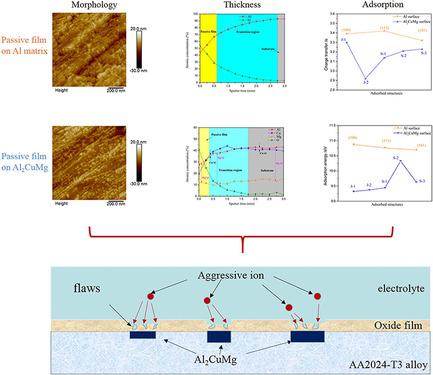当前位置:
X-MOL 学术
›
Adv. Eng. Mater.
›
论文详情
Our official English website, www.x-mol.net, welcomes your
feedback! (Note: you will need to create a separate account there.)
In Situ Electrochemical Atomic Force Microscopy and Auger Electro Spectroscopy Study on the Passive Film Structure of 2024‐T3 Aluminum Alloy Combined with a Density Functional Theory Calculation
Advanced Engineering Materials ( IF 3.4 ) Pub Date : 2019-09-10 , DOI: 10.1002/adem.201900386 Ni Li 1 , Chaofang Dong 1 , Chen Man 1 , Jizheng Yao 1
Advanced Engineering Materials ( IF 3.4 ) Pub Date : 2019-09-10 , DOI: 10.1002/adem.201900386 Ni Li 1 , Chaofang Dong 1 , Chen Man 1 , Jizheng Yao 1
Affiliation

|
The initial growth of the passive films on the Al2CuMg particle and Al matrix in AA2024‐T3 are investigated by in situ electrochemical atomic force microscopy (ECAFM) and ex situ characterization techniques in citric acid. The passive films are mainly composed of Al2O3 (34%), Al(OH)3 (8.4%), AlOOH (27.2%), CuO (19.4%), and Cu2O (11%). ECAFM images display that the film on the Al2CuMg particle is flawed and loose. Auger electro spectroscopy (AES) results show that the thickness of the passive film on the Al2CuMg particle is 1.4 nm, which is thinner than that on the Al matrix (2.4 nm). The combined ECAFM and AES results demonstrate that the corrosion resistance of the passive film on the Al2CuMg is weaker than that on the Al matrix. According to the density functional theory (DFT) calculations, the average charge transfer and adsorption energy of the adsorbates (O2−/OH−/H2O) on the Al surfaces are larger than that on the Al2CuMg surfaces, meaning that O2 and H2O preferably dissociate and adsorb on the Al surfaces. Moreover, the electronic interactions between the adsorbates and Al surfaces are stronger. This is the reason that the growth rate of the passive film on the Al2CuMg particle is slower at initial stages.
中文翻译:

结合密度泛函理论计算的2024-T3铝合金钝化膜结构的原位电化学原子显微镜和俄歇电子能谱研究
通过原位电化学原子力显微镜(ECAFM)和柠檬酸的异位表征技术研究了Aa2024-T3中Al 2 CuMg颗粒和Al基体上钝化膜的初始生长。钝化膜主要由Al 2 O 3(34%),Al(OH)3(8.4%),AlOOH(27.2%),CuO(19.4%)和Cu 2 O(11%)组成。ECAFM图像显示Al 2 CuMg颗粒上的薄膜有缺陷且疏松。俄歇电子能谱(AES)结果表明,Al 2上钝化膜的厚度CuMg颗粒为1.4 nm,比Al基体(2.4 nm)更薄。ECAFM和AES的综合结果表明,Al 2 CuMg上的钝化膜的耐蚀性比Al基体上的弱。根据密度泛函理论(DFT)计算,吸附物(O的平均电荷转移和吸附能2- / OH - / H 2 O)在Al表面比其在Al较大2 CuMg表面,这意味着O 2和H 2O优选在Al表面上解离并吸附。而且,被吸附物和Al表面之间的电子相互作用更强。这是在初始阶段Al 2 CuMg颗粒上的钝化膜的生长速度较慢的原因。
更新日期:2019-09-10
中文翻译:

结合密度泛函理论计算的2024-T3铝合金钝化膜结构的原位电化学原子显微镜和俄歇电子能谱研究
通过原位电化学原子力显微镜(ECAFM)和柠檬酸的异位表征技术研究了Aa2024-T3中Al 2 CuMg颗粒和Al基体上钝化膜的初始生长。钝化膜主要由Al 2 O 3(34%),Al(OH)3(8.4%),AlOOH(27.2%),CuO(19.4%)和Cu 2 O(11%)组成。ECAFM图像显示Al 2 CuMg颗粒上的薄膜有缺陷且疏松。俄歇电子能谱(AES)结果表明,Al 2上钝化膜的厚度CuMg颗粒为1.4 nm,比Al基体(2.4 nm)更薄。ECAFM和AES的综合结果表明,Al 2 CuMg上的钝化膜的耐蚀性比Al基体上的弱。根据密度泛函理论(DFT)计算,吸附物(O的平均电荷转移和吸附能2- / OH - / H 2 O)在Al表面比其在Al较大2 CuMg表面,这意味着O 2和H 2O优选在Al表面上解离并吸附。而且,被吸附物和Al表面之间的电子相互作用更强。这是在初始阶段Al 2 CuMg颗粒上的钝化膜的生长速度较慢的原因。











































 京公网安备 11010802027423号
京公网安备 11010802027423号